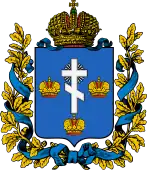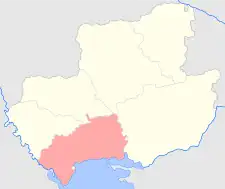Odessa uezd
The Odessa uezd[lower-alpha 1] was a county (uezd) of the Kherson Governorate of the Russian Empire. The uezd bordered the Tiraspol and Ananev uezds to the north, the Elisavetgrad uezd to the northeast, the Kherson uezd to the east, the Black Sea to the south, and the Akkerman uezd of the Bessarabia Governorate to the west. The administrative centre of the county was Odessa (Odesa).
Odessa uezd
Одесскій уѣздъ | |
|---|---|
 Coat of arms | |
 Location in the Kherson Governorate | |
| Country | Russian Empire |
| Governorate | Kherson |
| Established | 1825 |
| Abolished | 7 March 1923 |
| Capital | Odessa |
| Area | |
| • Total | 10,552.11 km2 (4,074.19 sq mi) |
| Population (1897) | |
| • Total | 610,042 |
| • Density | 58/km2 (150/sq mi) |
| • Urban | 69.56% |
| • Rural | 30.44% |
Administrative divisions
The subcounties (volosts) of the Odessa uezd in 1912 were as follows:[1]
| Name | Name in Russian | Capital |
|---|---|---|
| Alexandrovka volost | Александровская волость | Alexandrovka |
| Alexandro-feld volost | Александрофельдская волость | Alexandro-feld |
| Anatolevka volost | Анатольевская волость | Anatolevka |
| Antono-Kudintsevo volost | Антоно-Кудинцевская волость | Antono-Kudintsevo |
| Anchekrak-Ilyinskoe volost | Анчекракъ-Ильинская волость | Ilyinskoe |
| Baden volost | Баденская волость | Baden |
| Bolshoi-Buyalyk volost | Больше-Буялыкская волость | Bolshoi-Buyalyk |
| Belka volost | Бѣльчанская волость | Belka |
| Belyaevka volost | Бѣляевская волость | Bulyaevka |
| Gildendorf volost | Гильдендорфская волость | Gildendorf |
| Gradenits volost | Граденицкая волость | Gradenits |
| Zelts volost | Зельцская волость | Zelts |
| Ilyinka volost | Ильинская волость | Ilyinka |
| Kalagleya volost | Калаглейская волость | Kalagleya |
| Kovalevka volost | Ковалевская волость | Kovalevka |
| Korenikha volost | Коренихская волость | Korenikha |
| Kubanka volost | Кубанская волость | Kubanka |
| Kurisovo-Pokrovskoe volost | Курисово-Покровская волость | Kurisovo-Pokrovskoe |
| Kurtovka volost | Кутовская волость | Kutovka |
| Landau volost | Ландауская волость | Landau |
| Malo-Buyalykskoe volost | Мало-Буялыкская волость | Malo-Buyalykskoe |
| Mangeim volost | Мангеймская волость | Mangeim |
| Mariyinskoe volost | Маріинская волость | Mariyinskoe |
| Neizats volost | Нейзацкая волость | Neizats |
| Neifreidental volost | Нейфрейдентальская волость | Neifreidental |
| Nechayannoe volost | Нечаенская волость | Nechayannoe |
| Nikolaevskoe volost | Николаевская волость | Nikolaevskoe |
| Novo-Pokrovskoe volost | Ново-Покровская волость | Novo-Pokrovskoe |
| Petrovskoe volost | Петровская волость | Petrovskoe |
| Rasnopol volost | Раснопольская волость | Rasnopol |
| Rorbakh volost | Рорбахская волость | Rorbakh |
| Severinovka volost | Севериновская волость | Severinovka |
| Strasburg volost | Страсбургская волость | Strasburg |
| Tuzly volost | Тузловская волость | Tuzly |
Demographics
At the time of the Russian Empire Census on 28 January [O.S. 15 January] 1897, the Odessa uezd had a population of 610,042. including 322,899 men and 287,143 women. The majority of the population indicated Great Russian[lower-alpha 2] to be their mother tongue, with significant Jewish and Little Russian speaking minorities.[4]
| Language | Native speakers | Percentage |
|---|---|---|
| Great Russian[lower-alpha 2] | 228,436 | 37.45 |
| Jewish | 134,020 | 21.97 |
| Little Russian[lower-alpha 2] | 133,474 | 21.88 |
| German | 62,658 | 10.27 |
| Polish | 18,467 | 3.03 |
| Bulgarian | 8,290 | 1.36 |
| Greek | 7,535 | 1.24 |
| Romanian | 7,138 | 1.17 |
| White Russian[lower-alpha 2] | 1,631 | 0.27 |
| Tatar | 1,516 | 0.25 |
| Armenian | 1,405 | 0.23 |
| French | 1,141 | 0.19 |
| Italian | 723 | 0.12 |
| Czech | 622 | 0.10 |
| Latvian | 410 | 0.07 |
| Lithuanian | 400 | 0.07 |
| English | 357 | 0.06 |
| Turkish | 331 | 0.05 |
| South Slavic | 284 | 0.05 |
| Estonian | 231 | 0.04 |
| Georgian | 188 | 0.03 |
| Gipsy | 169 | 0.03 |
| Mordovian | 59 | 0.01 |
| Swedish | 48 | 0.01 |
| Others | 509 | 0.08 |
| Total | 610,042 | 100.00 |
Notes
- Prior to 1918, the Imperial Russian government classified Russians as the Great Russians, Ukrainians as the Little Russians, and Belarusians as the White Russians. After the creation of the Ukrainian People's Republic in 1918, the Little Russians identified themselves as "Ukrainian".[2] Also, the Belarusian Democratic Republic which the White Russians identified themselves as "Belarusian".[3]
References
- Волостныя, станичныя, сельския, гминныя правления и управления, а также полицейские станы всей России с обозначением места их нахождения [Volostny, stanichnaya, rural, communes of government and administration, as well as police camps throughout Russia with the designation of their location]. Kiev: Izd-vo T-va L. M. Fish. 1913. p. 191. Archived from the original on 2022-12-11.
- Hamm, Michael F. (2014). Kiev: A Portrait, 1800–1917. Princeton University Press. p. 83. ISBN 978-1-4008-5151-5.
- Fortson IV, Benjamin W. (2011). Indo-European Language and Culture: An Introduction. John Wiley & Sons. p. 429. ISBN 978-1-4443-5968-8.
- "Демоскоп Weekly - Приложение. Справочник статистических показателей". www.demoscope.ru. Retrieved 2019-12-20.